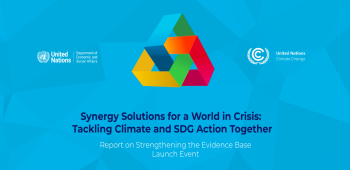
Chemicals and waste

Sustainable consumption and production

Sustainable tourism
Targets and Indicators

12.1
Implement the 10-Year Framework of Programmes on Sustainable Consumption and Production Patterns, all countries taking action, with developed countries taking the lead, taking into account the development and capabilities of developing countries
12.1.1
Number of countries developing, adopting or implementing policy instruments aimed at supporting the shift to sustainable consumption and production

12.2
By 2030, achieve the sustainable management and efficient use of natural resources
12.2.1
Material footprint, material footprint per capita, and material footprint per GDP
12.2.2
Domestic material consumption, domestic material consumption per capita, and domestic material consumption per GDP

12.3
By 2030, halve per capita global food waste at the retail and consumer levels and reduce food losses along production and supply chains, including post-harvest losses
12.3.1
(a) Food loss index and (b) food waste index

12.4
By 2020, achieve the environmentally sound management of chemicals and all wastes throughout their life cycle, in accordance with agreed international frameworks, and significantly reduce their release to air, water and soil in order to minimize their adverse impacts on human health and the environment
12.4.1
12.4.2
(a) Hazardous waste generated per capita; and (b) proportion of hazardous waste treated, by type of treatment

12.5
By 2030, substantially reduce waste generation through prevention, reduction, recycling and reuse
12.5.1
National recycling rate, tons of material recycled

12.6
Encourage companies, especially large and transnational companies, to adopt sustainable practices and to integrate sustainability information into their reporting cycle
12.6.1

12.7
Promote public procurement practices that are sustainable, in accordance with national policies and priorities
12.7.1
Number of countries implementing sustainable public procurement policies and action plans

12.8
By 2030, ensure that people everywhere have the relevant information and awareness for sustainable development and lifestyles in harmony with nature
12.8.1
Extent to which (i) global citizenship education and (ii) education for sustainable development are mainstreamed in (a) national education policies; (b) curricula; (c) teacher education; and (d) student assessment

12.a
Support developing countries to strengthen their scientific and technological capacity to move towards more sustainable patterns of consumption and production
12.a.1
Installed renewable energy-generating capacity in developing and developed countries (in watts per capita)

12.b
Develop and implement tools to monitor sustainable development impacts for sustainable tourism that creates jobs and promotes local culture and products
12.b.1
Implementation of standard accounting tools to monitor the economic and environmental aspects of tourism sustainability

12.c
Rationalize inefficient fossil-fuel subsidies that encourage wasteful consumption by removing market distortions, in accordance with national circumstances, including by restructuring taxation and phasing out those harmful subsidies, where they exist, to reflect their environmental impacts, taking fully into account the specific needs and conditions of developing countries and minimizing the possible adverse impacts on their development in a manner that protects the poor and the affected communities
12.c.1
Amount of fossil-fuel subsidies (production and consumption) per unit of GDP
Progress and Info
The crisis of unsustainable consumption and production patterns worldwide is fuelling the ongoing triple planetary crisis of climate change, nature loss and pollution. Domestic material consumption and material footprint continue to rise, some one billion meals worth of edible food are wasted every day in homes around the world and stockpiles of e-waste steadily grow. While countries are fulfilling their environmental agreement obligations and embracing comprehensive approaches to address environmental degradation, public funding supporting the production and consumption of fossil fuels has more than tripled since 2015, impeding the transition to net-zero emissions. Each stage of production or manufacturing presents an opportunity to reduce resource and fossil fuel use, foster innovation, conserve energy, cut emissions, and advocate for a circular economy approach.
Target 12.1: From 2019 to 2023, one-third of member states (63 countries) have reported 516 policy instruments related to sustainable consumption and production.
Target 8.4/12.2: From 2015 to 2022, Domestic Material Consumption (DMC) increased by 5.8%, and Material Footprint (MF) rose by 6.8%. Regional disparities between DMC and MF continue to grow, particularly between regions where MF is higher than DMC (Eastern and South-Eastern Asia, Europe and Northern America, Northern Africa and Western Asia) and those where MF is lower than DMC (Central and Southern Asia, Latin America and the Caribbean, Sub-Saharan Africa, Oceania), showing different patterns of material consumption and their corresponding environmental impact.
Target 12.3: In 2022, 19% of global food was wasted, totalling 1.05 billion tonnes, with household waste accounting for 60%. This waste generates significant greenhouse gas emissions, costing over $1 trillion annually, while 783 million people suffer from hunger. Addressing this issue is crucial for halving food waste by 2030, yet only 9 out of 193 countries have included food waste in their Nationally Determined Contributions as of 2022. Meanwhile, the percentage of food lost globally after harvest on farm, transport, storage, wholesale, and processing levels is estimated at 13.2% in 2021.
Target 12.4: Number of parties to international multilateral environmental agreements on hazardous waste, and other chemicals that meet their commitments and obligations in transmitting information as required by each relevant agreement:
o Minamata Convention on Mercury: Most Parties have met their obligations, with 94% appointing National Focal Points and 95% submitting complete national reports in 2023.
o Basel, Rotterdam, and Stockholm Conventions: Parties continue to make strides in meeting their obligations and in policy-making to keep pace with rapidly changing global circumstances, such as responding to the growing challenges created by contemporary waste streams such as plastic waste and e-waste, improving the procedure to control transboundary movements of wastes, and enlarging their scope with the listing of new chemical.
o Montreal Protocol: Parties consistently fulfil reporting obligations on the production and use of ozone-depleting substances, with 156 out of 198 ratifying the Kigali Amendment by January 2024, demonstrating an increased commitment to mitigating climate change under the Protocol.
Targets 12.4 and 12.5: In 2022, e-waste generation rose to 7.8 kg per capita from 6.2 kg per capita in 2015, but only 1.7 kg per capita was properly managed. Mismanaged e-waste leads to resource loss, increased use of virgin resources, and environmental hazards, underscoring the urgency for improved and environmentally sound management.
Target 12.6: In 2021-2022, 73% of companies included in the sample published sustainability reports, with the number of companies tripling since 2016. This growth was observed in all regions in 2022.
Target 12.c: Fossil fuel subsidies hit a record high of $1.53 trillion in 2022, reversing the declining trend observed from 2012 to 2020. The post-COVID energy price surge inflated these subsidies, prompting some governments to introduce new support measures. Consequently, public funding for oil, coal, and gas production and consumption more than doubled from 2021 to 2022 and tripled since 2015, impeding progress towards net-zero transition.





